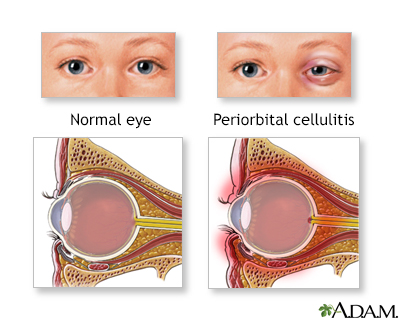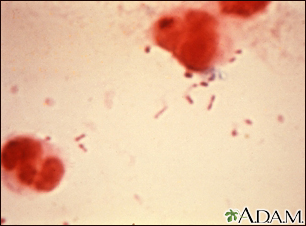Periorbital cellulitis
Preseptal cellulitis
Periorbital cellulitis is an infection of the eyelid or skin around the eye.
Images


Causes
Periorbital cellulitis can occur at any age, but more commonly affects children younger than 5 years old.
This infection can occur after a scratch, injury, or bug bite around the eye, which allows germs to enter the wound. It can also extend from a nearby site that is infected, such as the sinuses.
Periorbital cellulitis is different than orbital cellulitis, which is an infection of the fat and muscles around the eye. In contrast to periorbital cellulitis, orbital cellulitis is a dangerous infection, which can cause lasting problems and deeper infections.
Symptoms
Symptoms include:
- Redness around the eye or in the white part of the eye
- Swelling of the eyelid, whites of eyes, and surrounding area
This condition usually does not affect vision or cause eye pain.
Exams and Tests
Your health care provider will examine the eye, especially, eye movements and test for vision, and ask about the symptoms.
Tests that may be ordered include:
Treatment
Antibiotics are given by mouth, by shots, or through a vein (intravenously; IV) to help fight the infection.
Outlook (Prognosis)
Periorbital cellulitis almost always improves with treatment. In rare cases, the infection spreads into the eye socket, resulting in orbital cellulitis.
When to Contact a Medical Professional
Contact your provider right away if:
- The eye becomes red or swollen
- Symptoms get worse after treatment
- Fever develops along with eye symptoms
- It is difficult or painful to move the eye
- The eye looks like it is sticking (bulging) out
- There are vision changes
References
Durand ML. Periocular infections. In: Bennett JE, Dolin R, Blaser MJ, eds. Mandell, Douglas, and Bennett's Principles and Practice of Infectious Diseases. 9th ed. Philadelphia, PA: Elsevier; 2020:chap 116.
Olitsky SE, Marsh JD, Jackson MA. Orbital infections. In: Kliegman RM, St. Geme JW, Blum NJ, ed. Nelson Textbook of Pediatrics. 22nd ed. Philadelphia, PA: Elsevier; 2025:chap 674.
BACK TO TOPReview Date: 12/31/2023
Reviewed By: Jatin M. Vyas, MD, PhD, Associate Professor in Medicine, Harvard Medical School; Associate in Medicine, Division of Infectious Disease, Department of Medicine, Massachusetts General Hospital, Boston, MA. Also reviewed by David C. Dugdale, MD, Medical Director, Brenda Conaway, Editorial Director, and the A.D.A.M. Editorial team.

Health Content Provider
06/01/2025
|
A.D.A.M., Inc. is accredited by URAC, for Health Content Provider (www.urac.org). URAC's accreditation program is an independent audit to verify that A.D.A.M. follows rigorous standards of quality and accountability. A.D.A.M. is among the first to achieve this important distinction for online health information and services. Learn more about A.D.A.M.'s editorial policy, editorial process and privacy policy. A.D.A.M. is also a founding member of Hi-Ethics. This site complied with the HONcode standard for trustworthy health information from 1995 to 2022, after which HON (Health On the Net, a not-for-profit organization that promoted transparent and reliable health information online) was discontinued. |
The information provided herein should not be used during any medical emergency or for the diagnosis or treatment of any medical condition. A licensed medical professional should be consulted for diagnosis and treatment of any and all medical conditions. Links to other sites are provided for information only -- they do not constitute endorsements of those other sites. © 1997- 2025 A.D.A.M., a business unit of Ebix, Inc. Any duplication or distribution of the information contained herein is strictly prohibited.
